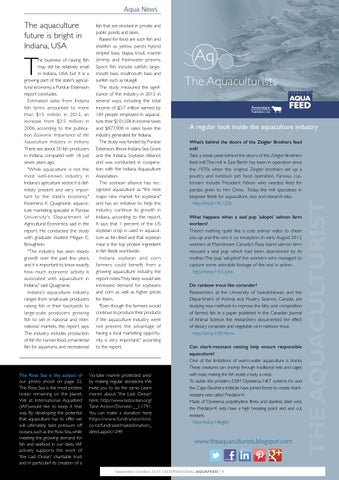Aqua News
i
i i i i i i i i i
i i i i i i i i i
i i i i i i i i i
i i i i i i i i i
'no-take marine protected area' by making regular donations. We invite you to do the same. Learn moren about 'the Last Ocean' here: http://www.lastocean.org/ Take-Action/Donate-__I.1791. You can make a donation here: https://www.fundraiseonline. co.nz/fundraise/makedonation_ direct.aspx?c=249
i i i i i i i i i
i
The Ross Sea is the subject of our photo shoot on page 32. The Ross Sea is the most pristine ocean remaining on the planet. We at International Aquafeed (IAF)would like to keep it that way. By developing the potential that aquaculture has to offer we will ultimately take pressure off oceans, such as the Ross Sea, while meeting the growing demand for fish and seafood in our diets. IAF actively supports the work of 'the Last Ocean' charitable trust and in particularl its creation of a
i i i i i i i i i
i i i i i i i i i
T
he business of raising fish may still be relatively small in Indiana, USA but it is a growing part of the state's agricultural economy, a Purdue Extension report concludes. Estimated sales from Indiana fish farms amounted to more than $15 million in 2012, an increase from $3.5 million in 2006, according to the publication Economic Importance of the Aquaculture Industry in Indiana. There are about 50 fish producers in Indiana, compared with 18 just seven years ago. "While aquaculture is not the most well-known industry in Indiana's agriculture sector, it is definitely present and very important to the state's economy," Kwamena K. Quagrainie, aquaculture marketing specialist in Purdue University's Depar tment of Agricultural Economics, said in the report. He conducted the study with graduate student Megan C. Broughton. "The industry has seen steady growth over the past few years, and it is important to know exactly how much economic activity is associated with aquaculture in Indiana," said Quagrainie. Indiana's aquaculture industry ranges from small-scale producers raising fish in their backyards to large-scale producers growing fish to sell in national and international markets, the report says. The industry includes production of fish for human food, ornamental fish for aquariums and recreational
fish that are stocked in private and public ponds and lakes. Raised for food are such fish and shellfish as yellow perch, hybrid striped bass, tilapia, trout, marine shrimp and freshwater prawns. Sport fish include catfish, largemouth bass, smallmouth bass and sunfish such as bluegill. The study measured the significance of the industry in 2012 in several ways, including the total income of $3.7 million earned by 169 people employed in aquaculture, their $101,506 in income taxes and $877,908 in sales taxes the industry generated for Indiana. The study was funded by Purdue Extension, Illinois-Indiana Sea Grant and the Indiana Soybean Alliance and was conducted in cooperation with the Indiana Aquaculture Association. The soybean alliance has recognised aquaculture as "the next major new market for soybeans" and has an initiative to help the industry continue its growth in Indiana, according to the report. It says that 1 percent of the US soybean crop is used in aquaculture as fish feed and that soybean meal is the top protein ingredient in fish feeds worldwide. Indiana soybean and corn farmers could benefit from a growing aquaculture industry, the report notes.They likely would see increased demand for soybeans and corn as well as higher prices for them. "Even though the farmers would continue to produce their products if the aquaculture industry were not present, the advantage of having a local marketing opportunity is very important," according to the report.
i i i i i i i i i
The aquaculture future is bright in Indiana, USA
The Aquaculturists
A regular look inside the aquaculture industry What’s behind the doors of the Zeigler Brothers feed mill? Take a sneak peek behind the doors of the Zeigler Brothers feed mill.The mill in East Berlin has been in operation since the 1970s when the original Zeigler brothers set up a poultry and livestock pet food operation. Famous customers include President Nixon who needed feed for pandas given to him China. Today, the mill specialises in bespoke feeds for aquaculture, zoo and research-labs. http://bit.ly/19L12Eb What happens when a seal pup 'adopts' salmon farm workers? There’s nothing quite like a cute animal video to cheer you up and this one is no exception. In early August 2013, workers at Mainstream Canada's Raza Island salmon farm rescued a seal pup which had been abandoned by its mother. The pup ‘adopted’ the workers who managed to capture some adorable footage of the seal in action. http://bit.ly/147LqX6 Do rainbow trout like coriander? Researchers at the University of Saskatchewan and the Department of Animal and Poultry Science, Canada, are studying new methods to improve the fatty acid composition of farmed fish. In a paper published in the Canadian Journal of Animal Science, the researchers documented the effect of dietary coriander and vegetable oil in rainbow trout. http://bit.ly/19EH6mx Can shark-resistant netting help ensure responsible aquaculture? One of the limitations of warm-water aquaculture is sharks. These creatures can chomp through traditional nets and cages with ease, making the fish inside a tasty a meal. To tackle this problem, DSM Dyneema, NET systems Inc and the Cape Eleuthera Institute have joined forces to create sharkresistant nets called Predator-X. Made of Dyneema polyethylene fibres and stainless steel wire, the Predator-X nets have a high breaking point and and cut resistant. http://bit.ly/18kgBj1
www.theaquaculturists.blogspot.com
September-October 2013 | International AquaFeed | 9
